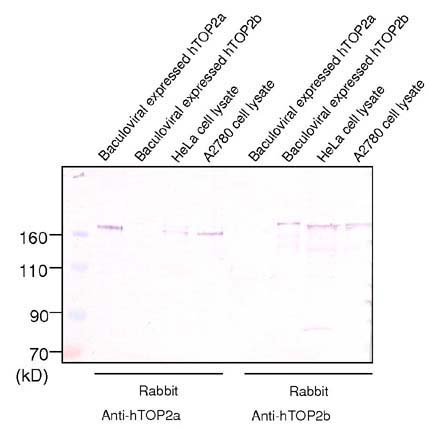|
Human Topoisomerase
IIa
Antibody
(Catalog # AP007)
Specificity:
Rabbit polyclonal antibody against Human
topoisomerase IIa.
Antigen used for immunizations:
Prokaryotic recombinant protein containing the amino acid residues
1095 to 1347 of the human topoisomerase IIa.
Storage
Buffer
and Reconstitution:
The ammonium
sulfate-precipitated whole serum
is kept in PBS with 1% BSA and then
lyophilized. Lyophilized antybody
should be reconstituted with 100 ul of
H2O before use.

Western blotting:
Working
dilution on
Western blotting 1:1000. 60 minutes primary antibody incubates at
25 oC (as shown in Fig).
Recommendations on use:
Immunofluorescence:
Typical working dilution on
frozen sections 1:200. 60 minutes primary
antibody incubates at 25 oC .
Positive controls:
HeLa cells.
Storage and stability:
Store unopened antibody at 4 oC or lower. Under these conditions, there is no significant loss in product performance
up to one year from the purchase date. The reconstituted antibody is
stable for at least two months when stored at 4 oC. For long term storage, it is
recommended that aliquots of the antibody are frozen at -20 oC(frost-free
freezers are not recommended). Repeated freezing and thawing must be avoided.
Prepare working dilutions on the day of use.
Legal consideration:
FOR RESEARCH USE ONLY.
Application:
Topoisomerases are nuclear enzymes
involved in a variety of cellular activities such as chromosome condensation,
DNA replication, transcription, recombination and segregation at mitosis. Topoisomerase IIa
is found in both prokaryotes and eucaryotes. This enzyme plays an important role
in DNA replication and transcription by relieving interlocking constraints of
DNA accumulation. Topoisomerase IIa
is activated when two double helices cross over on another. The enzyme makes a
DNA gate by breaking one double helix reversibly and let a second nearby double
helix pass, then reseals the break and dissociates from the DNA. Topoisomerase
protein levels increase following cell proliferation and cell cycle progression
from G1 or S and G-2-M phase. The phosphorylation of the enzyme also change
during the cell cycle. Phosphorylation and dephosphorylation of the
Topoisomerase IIa
is thought to regulate the enzyme activity in Drosphilia and Saccharomyces
cerevisiae. Threonine 1342 in Human Topoisomerase IIa
is phosphorylated throughout the cell cycle. Phosphorylation level of threonine
1342 is G-2M phase is as twice as much in G1 or S phase.
References:
Chang Y-H, Hwang J, Shang H-F, et al.
Characterization of human DNA Topoisomerase II as an autoantigen regognized by
patients with IDDM. Diabetes. 45: 408-414 (1996).
Holden J A, Rahn M P, Jolles C J, et
al.. Immunohistochemical detection of DNA topoisomerase I in formalin fixed,
paraffin wax embedded normal tissues and in ovarian carcinomas. J Clin Pathol:
Mol Pathol. 50:
247-253 (1997).
Li TK, Liu LF.
Tumor cell death induced by topoisomerase-targeting drugs. Annu Rev Pharmacol
Toxicol. 41:53-77 (2001).
McLeod H L, Douglas F, Oates M, et al..
Topoisomerase I and II activity in human breast, cervix, lung and colon cancer.
Int J Cancer. 59:
607-611 (1994).
Shero J H, Bordwell B, Rothfield N F, et
al.. High titers of autoantibodies to topoisomerase I (Scl-70) in sera from
scleroderma patients. Science.
231:
737-740 (1986).
|





